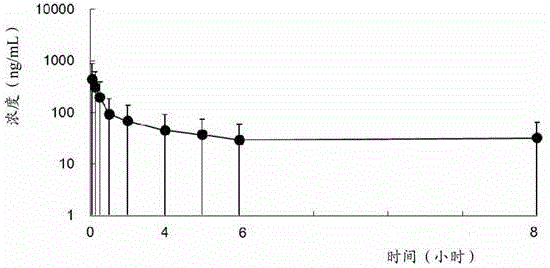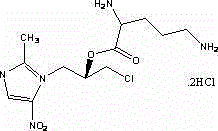Amino-acid ester water-soluble derivative of (S)-ornidazole and application thereof
A technology of levornidazole and amino acid ester, which can be used in medical preparations containing active ingredients, drug combinations, organic active ingredients, etc., and can solve the problems of harsh storage conditions and poor stability.
- Summary
- Abstract
- Description
- Claims
- Application Information
AI Technical Summary
Problems solved by technology
Method used
Image
Examples
Embodiment 1
[0060] Example 1 : Synthesis of (S)-3-chloro-1-(2-methyl-5-nitro-1H-imidazol-1-yl)propane-2-yl-2,6-diaminocaproic acid (Compound 1)
[0061] Under water bath conditions, N α -tert-butoxycarbonyl-N ε -tert-butoxycarbonyl-lysine (22mmol, 7.6g), N,N'-dicyclohexylcarbodiimide (4.4mmol, 0.91g), 4-dimethylaminopyridine (2.2mmol, 0.3g) , stirred and dissolved with anhydrous dichloromethane (30ml). Subsequently, levo-ornidazole (26 mmol, 5.7 g) was added and stirred overnight at room temperature. The insoluble solid was removed by filtration, and the filtrate was evaporated to dryness; ether was added to the residue, and insoluble impurities in the solution were removed by filtration. The filtrate was concentrated and quickly passed through the column with diethyl ether as the developing solvent to collect product fractions. Concentration under reduced pressure gave 3.7 g of the product; the yield of compound 1 was 64.9%.
[0062] ESI-MS m / z: 347 (M+1) +
Embodiment 2
[0063] Example 2 : Synthesis of (S)-3-chloro-1-(2-methyl-5-nitro-1H-imidazol-1-yl)propane-2-yl-2-amino-5-guanidinovaleric acid (Compound 2)
[0064] Under water bath conditions, N α - tert-butoxycarbonyl-arginine hydrochloride (22mmol, 7.23g), N, N'-dicyclohexylcarbodiimide (4.4mmol, 0.91g), 4-dimethylaminopyridine (2.2mmol, 0.3g), stirred and dissolved with anhydrous dichloromethane (30ml). Subsequently, levo-ornidazole (26 mmol, 5.7 g) was added and stirred overnight at room temperature. The insoluble solid was removed by filtration, and the filtrate was evaporated to dryness; ether was added to the residue, and insoluble impurities in the solution were removed by filtration. The filtrate was concentrated and quickly passed through the column with diethyl ether as the developing solvent to collect product fractions. Concentration under reduced pressure gave 4.0 g of the product; the yield of compound 2 was 70.2%.
[0065] ESI-MS m / z: 389 (M+1) +
Embodiment 3
[0066] Example 3 : (S)-3-Chloro-1-(2-methyl-5-nitro-1H-imidazol-1-yl)propan-2yl-2-amino-3-(4-imidazolyl)propionic acid (compound 3) Synthesis of
[0067] Under water bath conditions, N α -tert-butoxycarbonyl-Nim-trityl-histidine (22mmol, 7.6g), N,N'-dicyclohexylcarbodiimide (4.4mmol, 0.91g), 4-dimethylaminopyridine (2.2mmol, 0.3g), stirred and dissolved with anhydrous dichloromethane (30ml). Subsequently, levo-ornidazole (26 mmol, 5.7 g) was added and stirred overnight at room temperature. The insoluble solid was removed by filtration, and the filtrate was evaporated to dryness; ether was added to the residue, and insoluble impurities in the solution were removed by filtration. The filtrate was concentrated and quickly passed through the column with diethyl ether as the developing solvent to collect product fractions. Concentration under reduced pressure gave 4.2 g of the product; the yield of compound 3 was 73.6%.
[0068] ESI-MS m / z: 356 (M+1) +
PUM
 Login to View More
Login to View More Abstract
Description
Claims
Application Information
 Login to View More
Login to View More - R&D
- Intellectual Property
- Life Sciences
- Materials
- Tech Scout
- Unparalleled Data Quality
- Higher Quality Content
- 60% Fewer Hallucinations
Browse by: Latest US Patents, China's latest patents, Technical Efficacy Thesaurus, Application Domain, Technology Topic, Popular Technical Reports.
© 2025 PatSnap. All rights reserved.Legal|Privacy policy|Modern Slavery Act Transparency Statement|Sitemap|About US| Contact US: help@patsnap.com



